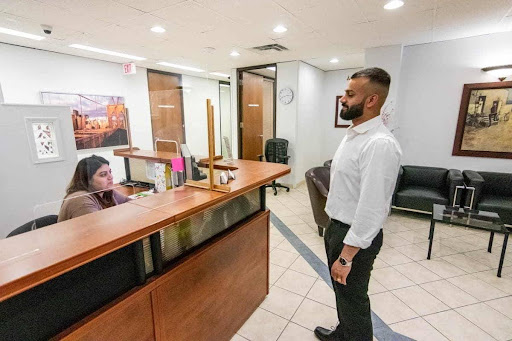In today’s competitive business landscape, having a small office space means something other than compromising on productivity or creativity. In fact, with the right strategies and mindset, small office spaces can offer significant advantages, fostering collaboration, efficiency, and innovation. In this article, we’ll explore practical strategies to maximize the potential of limited office space, empowering businesses to thrive in compact environments.
- Embrace Minimalism:
Adopting a minimalist approach to office design and decor can work wonders when space is at a premium. Keep furniture and decorations to a minimum, opting for sleek, multipurpose pieces that serve aesthetic and functional purposes. Declutter regularly to maintain a clean and organized workspace, eliminating distractions and creating an environment conducive to focus and productivity.
- Optimize Layout and Furniture:
Careful planning of office layout and furniture arrangement is crucial in small spaces. Consider open-plan designs to maximize available square footage, allowing flexibility and collaboration among team members. Choose modular furniture that can be easily reconfigured to adapt to changing needs and workflows. Invest in space-saving solutions such as wall-mounted desks, foldable tables, and ergonomic chairs to maximize comfort and efficiency without sacrificing space.
- Utilize Vertical Space:
In small office environments, every inch counts. Use vertical space by installing shelving units, storage cabinets, and wall-mounted organizers to keep supplies, documents, and equipment off the floor and within easy reach. Vertical storage maximizes space efficiency and adds visual interest to the office environment, creating a sense of depth and dimension.
- Implement Digital Solutions:
Reduce reliance on physical storage and paperwork by digitizing documents and embracing cloud-based solutions for file storage, collaboration, and communication. Cloud storage eliminates the need for bulky filing cabinets and allows team members to access documents and data anytime. Invest in digital tools and software that streamline workflows, automate tasks, and enhance collaboration, freeing up physical space and boosting productivity.
- Foster a Flexible Work Culture:
Embrace flexible work arrangements such as remote work, hot desking, and flexible scheduling to accommodate varying space needs and workstyles. Encourage employees to work from home or alternative locations when feasible, reducing the demand for physical office space and minimizing overcrowding. Implement flexible seating arrangements and shared workstations to optimize space utilization and promote collaboration among team members.
- Create Multipurpose Spaces:
Maximize the functionality of small office spaces by creating multipurpose areas that serve multiple functions throughout the day. For example, a conference room can double as a collaborative workspace or presentation area, while a kitchenette can function as a casual meeting space or breakout area. Businesses can make the most of limited square footage and accommodate diverse needs by designing versatile spaces that adapt to different activities and requirements.
- Prioritize Ergonomics and Comfort:
Despite limited space constraints, it’s essential to prioritize employee comfort and well-being. Invest in ergonomic furniture and accessories to support proper posture and reduce the risk of musculoskeletal injuries. Provide ample natural light, air circulation, and ergonomic workstations to create a healthy, comfortable work environment that enhances productivity and morale.
- Foster a Collaborative Culture:
Encourage collaboration and teamwork among employees to maximize the potential of small office spaces. Foster a culture of openness, communication, and creativity, where team members feel empowered to share ideas, collaborate on projects, and support each other’s growth and development. Implement collaborative tools and technologies that facilitate communication and collaboration, bridging the gap between remote and in-office employees and fostering a sense of unity and camaraderie.
- Embrace Remote Work:
Harness the benefits of remote work to alleviate space constraints and reduce overhead costs associated with maintaining a physical office space. Encourage employees to work remotely, either full-time or flexibly, leveraging technology to stay connected and productive. Embrace virtual meetings, digital collaboration tools, and remote project management platforms to facilitate seamless communication and collaboration across distributed teams.
- Continuously Adapt and Evolve:
Adaptability is critical to success in a rapidly changing business landscape. Continuously evaluate and optimize your small office space strategy, seeking feedback from employees and stakeholders to identify areas for improvement. Embrace innovation and experimentation, exploring new technologies, design concepts, and workflow solutions that enhance efficiency, collaboration, and employee satisfaction. By remaining agile and responsive to evolving needs and trends, businesses can unlock the full potential of their limited office space and thrive in today’s dynamic environment.
In conclusion, while small office spaces in Calgary may present challenges, they offer unique opportunities for innovation, collaboration, and efficiency. By embracing Minimalism, optimizing layout and furniture, utilizing vertical space, implementing digital solutions, fostering a flexible work culture, creating multipurpose spaces, prioritizing ergonomics and comfort, fostering a collaborative culture, embracing remote work, and continuously adapting and evolving, businesses can maximize the potential of their limited office space and position themselves for long-term success. With the right strategies and mindset, small office spaces can catalyze creativity, productivity, and growth, enabling businesses to thrive in any environment.


